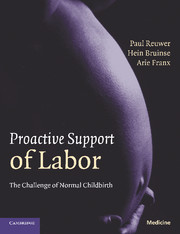Book contents
- Frontmatter
- Contents
- Foreword
- Acknowledgments
- Web-Forum
- 1 General introduction
- Section 1 A wake-up call
- Section 2 Back to basics
- 7 Lessons from nature
- 8 Elementary biophysics of birth
- 9 First-stage labor revisited
- 10 Second-stage labor redefined
- 11 Definitions and verbal precision
- Section 3 Proactive support of labor
- Index
- References
8 - Elementary biophysics of birth
Published online by Cambridge University Press: 08 September 2009
- Frontmatter
- Contents
- Foreword
- Acknowledgments
- Web-Forum
- 1 General introduction
- Section 1 A wake-up call
- Section 2 Back to basics
- 7 Lessons from nature
- 8 Elementary biophysics of birth
- 9 First-stage labor revisited
- 10 Second-stage labor redefined
- 11 Definitions and verbal precision
- Section 3 Proactive support of labor
- Index
- References
Summary
Although the basic physiology of parturition is a permanent design of nature, the professional conduct and care of normal childbirth vary significantly (Chapter 5). This diversity in approaches to labor and delivery reflects differences in appreciation or knowledge of the elementary processes that control normal birth. By and large, interventionist obstetricians tend to override biology, whereas conservative caregivers often allow labor to derail from the physiological track for too long. If scrutinized, both dogmatic approaches allow professionals to attend birth with neglect or even ignorance of the basic natural science of normal parturition.
Rational birth care must be based on a solid understanding of the biology of birth and this is precisely the hallmark of proactive support of labor (Section 3). For comprehension of the physiological basis of this method of care, this chapter is of critical importance to all professionals involved in childbirth: physicians, midwives, and nurses. Laypersons without a medical background, however, might be discouraged from further reading by the bio-technical aspects of birth in this chapter, and may wish to scan only the boxed key points and summary and proceed directly to Chapter 9.
The prelabor preparation of the uterus
The function of the uterus changes radically at the end of pregnancy. For nine months the uterus maintains a state of functional quiescence in which the natural contractility of the myometrium is effectively suppressed and the resistance of the cervix is kept high enough to ensure that the fetus remains safely inside the womb.
- Type
- Chapter
- Information
- Proactive Support of LaborThe Challenge of Normal Childbirth, pp. 59 - 69Publisher: Cambridge University PressPrint publication year: 2009



